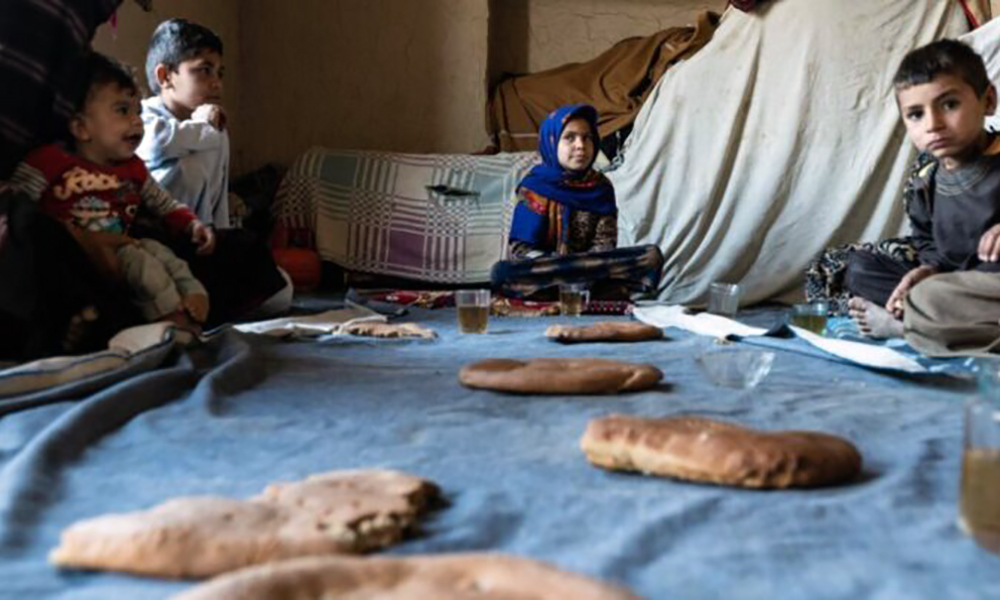Latest News
Around 8,000 terrorists gather along Afghan-Tajikistan border

Around eight thousand terrorists including Daesh group are present along Afghanistan-Tajikistan border, head of strategic studies of Tajikistan said.
Khoday Nazar Khoday Bardi, head of Tajikistan’s strategic studies declared that Tajikistan is preparing to prevent entering extremist groups from Tajikistan and Afghanistan border.
“Tajikistan has the readiness to stand against any extremist groups that want to enter to this country,” Bardi said.
The ministries of interior and defense have also said that Daesh is the enemy of Afghanistan and they will fight against them.
“Daesh is a serious threat for Afghanistan, region and the world’s security,” Sidiqi Sidiqi, spokesman of interior ministry said.
Dawlat Waziri, spokesman of defense ministry said, “The enemy is enemy; it does not matter under Daesh or any name, we will fight against them.”
Since the beginning of this year, increasing reports about fighters operating inside Afghanistan under the black banner of Daesh, the Arabic acronym of the self-declared Islamic State, have emerged. First, there were rumors alleging that foreign fighters, supposedly linked to Daesh, appeared in Afghanistan, specifically in the western province of Farah, bordering Iran, and the southern provinces of Helmand and Zabul, bordering Pakistan. Those rumors were followed by sightings of black-dressed warriors.
In the beginning, Afghan officials were reluctant to state that those fighters were affiliated with Daesh and referred to them simply as terrorists. Later, they often said that the black-clad fighters were mere splinter groups of the Taliban and the Haqqani Network that just changed their names and that there was no reason to fear the intrusion of the Islamic State into Afghanistan.
Then, a spokesman of Daesh announced the group’s expansion into Afghanistan and Pakistan.
The Afghan media was mesmerized by the idea of Daesh creeping into Afghanistan. It did not take long until the first pictures were published and broadcast alongside the scarce actual news. Arguably the most iconic was a short film of black-hooded men riding on horses through a forest under the fluttering black banner of the caliphate that was played repeatedly in the Afghan news.
Afghans were immediately captured by the thought of Daesh spreading into Afghanistan. Despite official statements claiming that those fighters were merely part of the Taliban and other insurgents simply calling themselves the Islamic State, many Afghans were anxiously talking about Daesh establishing itself in the country. Then, officials — among them Senators and Governors — publicly stated that Daesh was not only operating in Farah, Helmand, and Zabul, but also in the southeastern province of Ghazni, and the northern provinces of Faryab, bordering Turkmenistan, and Kunduz, bordering Tajikistan.
On that date, Afghan security forces arrested 13 alleged affiliates of Daesh in the Bagram district in the province of Parwan and acknowledged the existence of persons affiliated with Daesh in Afghanistan.
On the same day, Abu Muhammad al-Adnani, a spokesman of Daesh,announced the expansion of the self-styled caliphate to the lands of Khorasan — the ancient name for the region encompassing Afghanistan, Pakistan, and other nearby areas. He also named Hafez Saeed Khan as governor of Khorasan and Abdul Rauf Khadim as his deputy.
As facts about Daesh in Khorasan are scarce and can often not be verified, it remains unclear whether the mentioned arrests and the announcement of the Khorasan Shura really confirm the existence of Daesh inside Afghanistan or if the black-dressed fighters are just Taliban and other insurgents trying to bolster their reputation.
The announcement of the expansion of Daesh to Khorasan does not necessarily contradict the second option. Daesh originated from a group known as al Qaeda in Iraq, but then split with core al Qaeda and is now in a fierce competition with its former patron over the leadership of the global jihad. Therefore, the Islamic State seeks to evolve from its roots in Syria and Iraq and gain a global status and would, arguably, willingly embrace groups in faraway lands, even if there is no or little control or communication between Daesh and such groups.
Accordingly, the Afghan Ministry of the Interior still deems the alleged activities of Daesh to be nothing more than a cunning public relations scheme; nonetheless, Afghan President Ashraf Ghani recently warned of the threat that Daesh poses to Afghanistan.
Even without hard evidence of a real presence on the ground, the looming specter of Daesh will likely continue to haunt Afghanistan. However, it seems also clear that the caliphate will not find the Promised Land in ancient Khorasan, but will instead face great tribulations and rifles and bayonets will multiply against them. It remains to be seen if they are up to the task; in their view, this is for Allah to decide.

Latest News
Pakistan’s top general calls on IEA to pick between ties with Islamabad or TTP

Pakistan’s newly appointed armed forces chief called on the Islamic Emirate of Afghanistan (IEA) on Monday to choose between maintaining ties with Islamabad or supporting the Tehreek-i-Taliban Pakistan (TTP).
Munir made his remarks at his headquarters in the garrison city of Rawalpindi, where he received a guard of honor from all three branches of the military, marking the launch of Pakistan’s new joint military command.
Munir said that the new Defence Forces Headquarters marks a historic step, creating a unified tri-services command to boost coordination across land, air, sea, cybersecurity and information domains amid rising security threats, according to a military statement.
Munir told officers that a “clear message” had been conveyed to the Islamic Emirate in Kabul that it must choose between Pakistan and the TTP.
The Islamic Emirate has not yet responded to Munir’s remarks.
Relations between Afghanistan and Pakistan have been deteriorating since October, when several days of fighting left dozens dead and hundreds injured.
Pakistani officials have consistently claimed that attacks in the country are being organized by militants based in Afghanistan. The Islamic Emirate, however, has rejected this claim and said that Afghanistan cannot be held responsible for Pakistan’s security.
Latest News
Mushroom harvest begins in Kandahar

In Kandahar, farmers who established mushroom farms with the support of international organizations have now begun harvesting their crops.
The Directorate of Agriculture, Irrigation, and Livestock of Kandahar stated that, as a result of its efforts and with financial support from the United Nations Office on Drugs and Crime (UNODC) and technical assistance from the Dutch Committee for Afghanistan, essential supplies worth $20,000 were distributed to 30 needy families in Khakrez district to establish mushroom farms. The harvesting process has now started.
Officials say the program aims to promote alternative crops to opium poppy, improve farmers’ livelihoods, introduce high-yield plants, and expand modern and standardized farming practices. According to them, each farmer can produce up to 10 kilograms of mushrooms in one month from just one kilogram of seeds at home—a process that is simple, low-cost, and highly profitable.
Mohammad Hanif Haqmal, spokesperson for the Kandahar Directorate of Agriculture, said: “For around 30 families, 23 types of tools necessary for mushroom farming were distributed. Seeds were also provided so they could establish farms and harvest crops. This is the first time mushroom is being cultivated in Kandahar. The Directorate of Agriculture will continue its efforts to promote this crop in other areas of the country so people can establish farms at home and increase their income. In Kandahar, the price of one kilogram of mushroom ranges between 350 and 400 Afghanis.”
Officials from the Dutch Committee for Afghanistan also confirmed that 23 types of tools and necessary materials for mushroom cultivation were previously distributed to the families, and the harvest is now underway. They consider the plant a suitable alternative to opium poppy and said they will continue supporting the farmers.
Abdulhadi Dawoodzi, representative of the Dutch Committee for Afghanistan in Kandahar, added: “We distributed 20 types of materials and tools necessary for planting and harvesting mushroom to 30 families, worth $20,000. This support serves as an alternative to opium cultivation.”
Farmers view mushroom as a viable substitute for opium poppy. They say the crop requires less effort and yields higher profits, making it a suitable option, especially during drought conditions.
Sibghatullah, a Kandahar farmer, said: “Mushroom can serve as a complete alternative to opium and hashish. Drought is intensifying every year, and this crop is a good substitute. We ask the organization to establish more farms and help market our products.”
Another farmer, Mohammad Naseem, added: “We can sell mushroom in local markets and to neighbors. Compared to opium and other narcotic crops, it is a better cultivation option.”
Officials from the Kandahar Directorate of Agriculture said that in recent months, they have increased efforts to identify and promote alternative crops and have implemented several programs to introduce high-yield plants suitable for Kandahar’s climatic conditions.
Latest News
WFP slashes aid by 80% as Afghanistan’s hunger crisis worsens
According to UN estimates, 3.5 million Afghan children under five are suffering from acute malnutrition, while more than 1.2 million pregnant and breastfeeding women face severe nutritional deficiencies.

The UN World Food Programme (WFP) has reduced its food assistance in Afghanistan by 80 percent, warning that hunger and malnutrition are escalating at a dangerous pace.
Due to severe funding shortages, the agency has cut support from 10 million vulnerable Afghans to just two million.
WFP officials say the situation is deteriorating rapidly. Deputy Executive Director Carl Skau cautioned that with winter fast approaching, Afghan children face an increased risk of death from severe malnutrition and freezing temperatures.
“Because of budget shortages, we have been forced to reduce our assistance in Afghanistan from 10 million people to two million,” Skau said.
“This winter, we cannot support large numbers of vulnerable families, and many children may lose their lives due to hunger and cold. Last year was one of the worst years for humanitarian aid, and we expect a 40% funding gap again in 2026.”
Skau warned that malnutrition among women and children could reach levels not seen in years.
According to UN estimates, 3.5 million Afghan children under five are suffering from acute malnutrition, while more than 1.2 million pregnant and breastfeeding women face severe nutritional deficiencies.
UN agencies have repeatedly stressed throughout the year that shrinking humanitarian budgets have left them unable to reach millions of Afghans still in urgent need of assistance.
-

 Business3 days ago
Business3 days agoAriana Afghan Airlines boost air trade with arrival of new cargo aircraft
-

 Business4 days ago
Business4 days agoIEA demands assurances from Islamabad before trade routes reopen
-

 Latest News4 days ago
Latest News4 days agoIran offers fully funded virtual education for Afghan students returning from abroad
-

 Sport2 days ago
Sport2 days agoILT20: Nissanka fires Gulf Giants to four-wicket win over Dubai Capitals
-

 Latest News4 days ago
Latest News4 days agoImran Khan accuses Army Chief of ‘igniting’ Pakistan–Afghanistan tensions
-

 Sport3 days ago
Sport3 days agoFIFA confirms all 12 groups for 2026 World Cup
-

 Latest News5 days ago
Latest News5 days agoAfghanistan occupation mired in corruption, waste and unrealistic goals: SIGAR
-

 Regional4 days ago
Regional4 days agoPutin questions US punishing India for buying Russian oil















